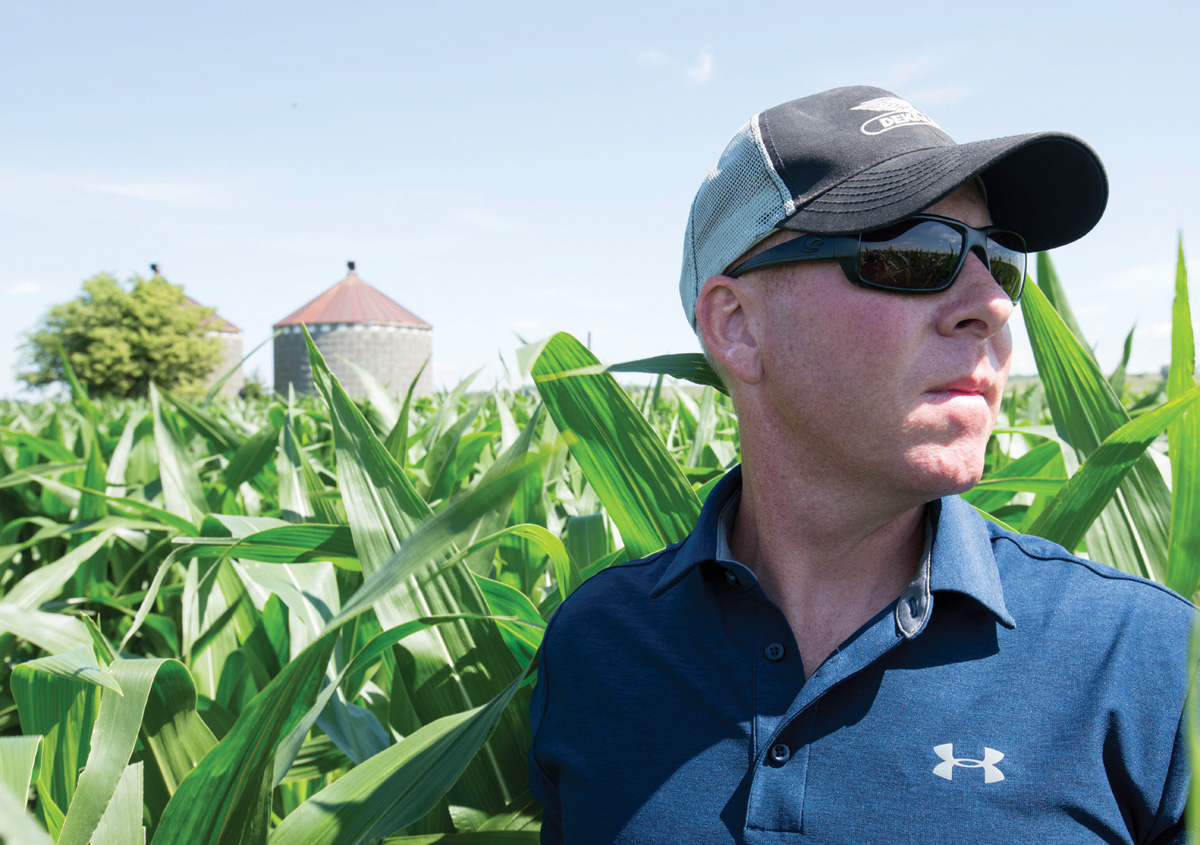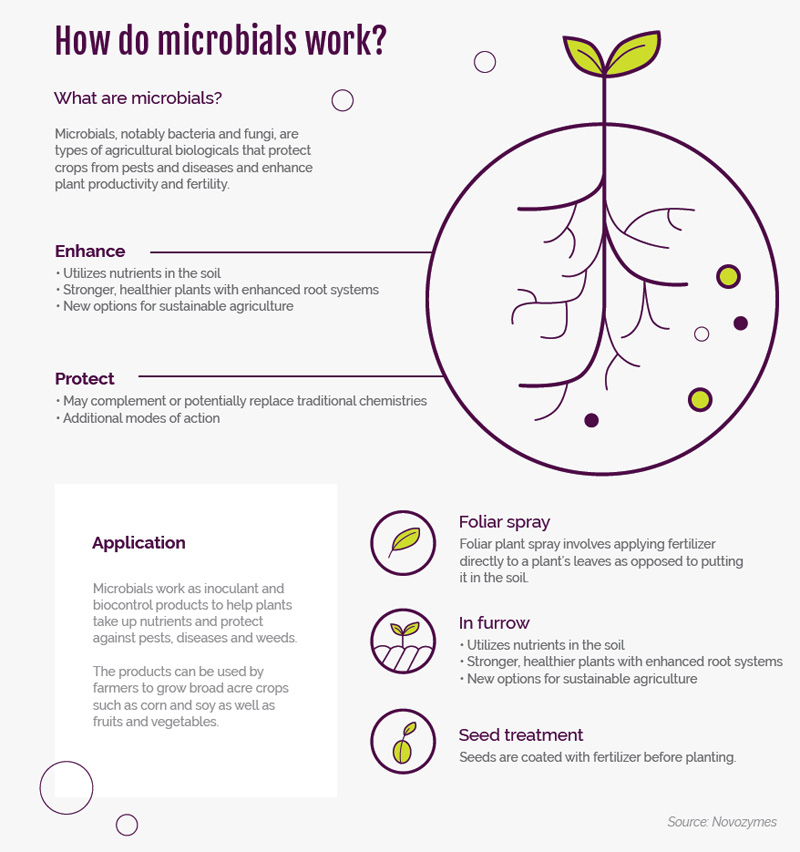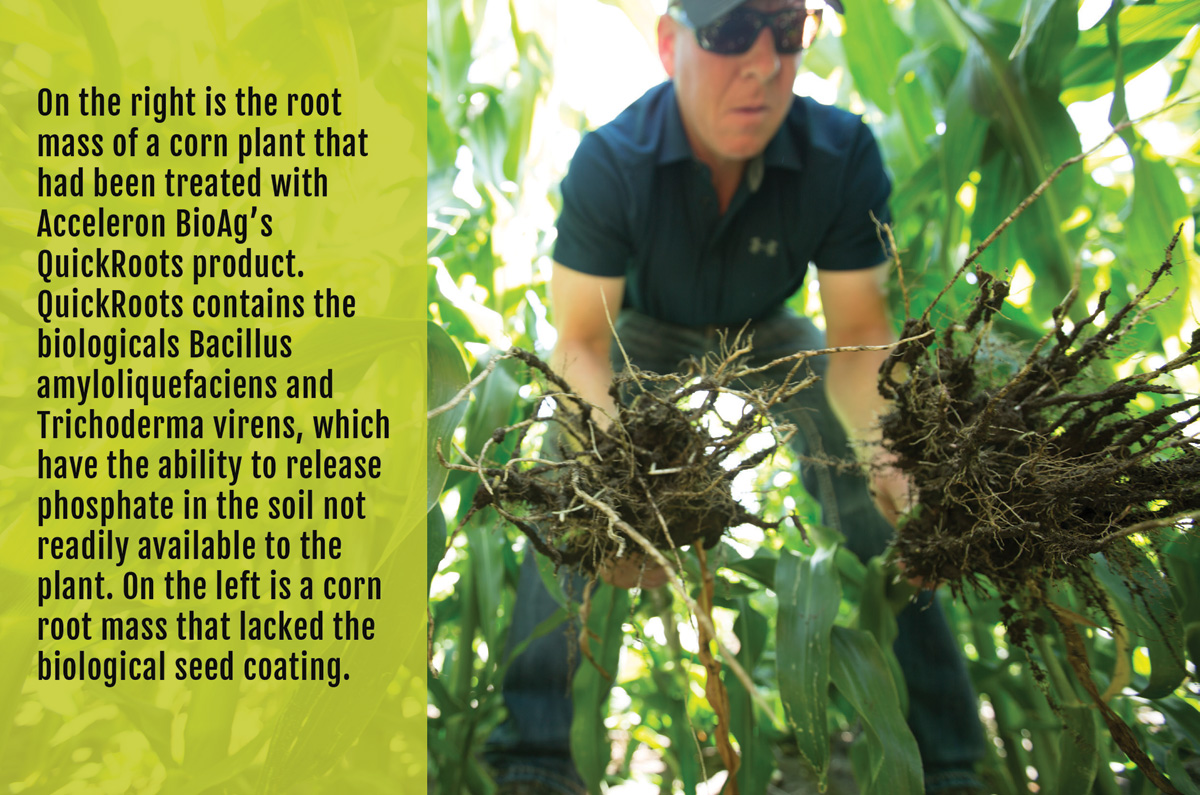Nick Emanuel, fourth-generation farmer, North Bend, Neb.
Spread across his 2,000-acre farm in North Bend, Neb., Nick Emanuel is field testing roughly 500 acres of corn planted from seeds coated with powerful microbes.
“We’ve always been big believers in precision ag practices and keeping on the leading edge of technology,” says Emanuel, a fourth-generation farmer in his third season of testing. “We’ve planted the test crops side by side with traditional crops, and you can actually see the difference.”
Last year, for one of the microbetreated plots, that difference meant yields ten bushels better than the control plot. And, after a devastating wind storm late last season, the only rows left standing were the test corn.
“We believe these biologicals are one part of the solution, another piece of the puzzle,” says Emanuel. “Environmental aspects are also a key concern for us, and we’ve seen we can decrease fertilizer usage with the microbial seeds. So when we had a chance to partner with the BioAg Alliance for these tests, we took it.”
The BioAg Alliance is a partnership between Novozymes, a world leader in bioinnovation with roots dating back to the 1920s, and ag biotech leader Monsanto.
First announced in late 2013, the partners pledged to “transform research and commercialization of sustainable microbial products that will provide a new platform of solutions for growers around the world.”
The collaboration would match Novozymes’ established product portfolio and microbial discovery and production abilities with Monsanto’s commercial capabilities, global field-testing network and its highlydeveloped “seeds and traits discovery system.”
They hoped, somehow, to understand how microbes — those microorganisms that do everything from breaking down organic matter to creating fermentation — affect agriculture, and then to harness and apply that knowledge.
Here’s one issue: An estimated 60 million microbes live on each square inch of the above-ground plants. Each spoonful of soil contains another 50 billion microbes (and 10,000 species), give or take.
“To me, looking at microbes can feel like looking at the stars,” says Gwyn Beattie, a professor of plant pathology and microbiology at Iowa State University. “You can see some of the stars, but you know there are a lot of stars you can’t see. The better the telescope, the more you can learn about them, and that’s exactly what we’re doing with the microbe with this research.”
Beattie, one of the co-authors of the “How Microbes Can Help Feed the World” report, says our knowledge of microbes has increased steadily over the last ten years. “We’ve come so far, we’re asking sophisticated questions we couldn’t even imagine a decade ago,” she says. “It can be expensive, but this is an area where the research will be worth the results.”
Microbes — especially these interconnected collections of fungi and bacteria that thrive in the soil — can be incredibly beneficial to agriculture. They can help plants soak up nutrients and minerals, strengthen and lengthen root systems, and deal with environmental stress.
Certain microbes can bolster immunity against diseases and repel pests.
Those traits, when enhanced in plants through naturally occurring microbes, can raise yields, lessen fertilizer usage, increase resiliency to things like wind and flood and drought, and decrease the need for pesticides.
“Basically, what we do is find the right microbes,” says Thomas Batchelor, the Vice President for BioAg at Novozymes. “There are billions of microbes in nature. Part of the art is to find the right ones and isolate them. Then, using our technology, we try to figure out which microbes have a beneficial effect.”
So, beginning in 2014, the BioAg Alliance started collecting soil samples, isolating and testing microbes, and ramping up small-scale fermentation to cultivate the good microbes in a process similar to fermenting beer. Now working as a partnership, they conducted the first-ever large-scale testing of microbe-coated seeds and analyzed those results. Then they did it all over again. And again.
Nebraska farmer Nick Emanuel shows the impact of biological products on corn roots.
By 2015, the Alliance was testing more than 2,000 microbial strains across 500,000 field trial plots in more than 50 locations in the United States.
By 2017, the Alliance partners had released their first jointly developed commercial product, Acceleron B-300 SAT, which activates microbes to strengthen root systems and increase nutrient access. Another new product, Acceleron B-360 ST, is slated for release in 2019.
Today, just five years since first forming that partnership, BioAg Alliance products are used on more than 80 million acres of farmland in North and South America.
Emanuel says plot trials have shown a corn crop production increase of six bushels per acre (from 185.4 to 191.7), all while reducing fertilizer costs. The BioAg Alliance stresses that, like any agriculture input, results can vary based upon an individual farm’s factors including rainfall, soil type, etc.
“If you look at the broader societal impact, it’s a really compelling vision,” says Batchelor, who will soon be moving to Novozymes’ North Carolina offices after a decade in the company’s Copenhagen headquarters. “You can actually increase the plant’s ability to uptake nutrients by adding naturally occurring microbes to the field and thereby reduce the use of chemical fertilizers and pesticides.”
The BioAg Alliance predicts that, by 2025, their products will be used on between 250 million and 500 million acres around the world, equivalent to 25 percent to 50 percent of all U.S. farmland.
The results — and the positive projections — don’t surprise Dave Bushong, Senior Vice President of Research at POET, which has partnered with Novozymes on enzyme technology for more than a decade. “POET has been involved in a number of technical collaborations with Novozymes, and we know their history of making ag environmentally friendly. The BioAg Alliance has been a great promoter of this.”
In an era in which ag advances — like genetically modified seeds — have sometimes been met with public pushback, it’s hard not to argue the big-picture positives of microbial research.
Just five years into the BioAg Alliance, the group has shown that this research can lead to higher yields while using less fertilizer, fewer pesticides and less water, all while producing less carbon dioxide.
“I find hope in the fact that you have companies getting together — like with the BioAg Alliance — to try and do the right things environmentally,” says Beattie. “Microbes can shift the way people look at agriculture. It may be incremental, but they can change the way fertilizers and pesticides are used. We can actually take something that occurs in nature to create healthier soils and plants.”
When forming the BioAg Alliance, the two companies kept one important, big-picture goal in mind, according to Batchelor: “transforming agriculture through research.”
“The BioAg Alliance has a very clear mission of making microbials a mainstream technology and gaining a better understanding of the science to help everyone,” says Batchelor. “We are at a stage where the products are getting better quickly, and people in agriculture are understanding how important it is. We believe this research is truly transformational because it opens up so many opportunities for farmers all over the world. ”
One of those farmers, Nick Emanuel, says he’s reaping those rewards — those yields, that plant resiliency, the decrease in fertilizer usage — by simply planting a better seed. “The great thing about this product is that, as a farmer, you don’t have to do anything different. The seeds are already treated, and all we do is load the planter like normal,” he says. “That’s it. It’s just choosing a seed. It’s that simple to do the right thing for the environment.”









